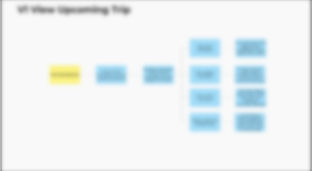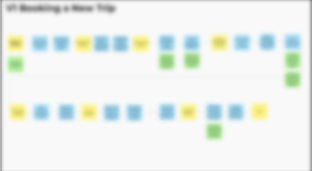ONLINE TRAVEL BOOKING EXPERIENCE

OVERVIEW
Our client, a pre-seed travel startup in the ideation and prototyping stage of product development, sought to solidify its market problem, identify key features and functions, and test its concept through targeted internet advertisements.
This project was undertaken as part of the Miami University Entrepreneurial Consulting capstone. Our multidisciplinary team of three collaborated closely with the company founder, conducting bi-weekly client meetings and regular ideation sessions to drive progress and refine the startup’s vision.
ROLE
Product Designer
Creative
Brand Designer
Standup/Meeting lead
Presenter
Abstract/Background
The startup I consulted for is developing an online travel tool that provides meaningful, personalized travel suggestions tailored to the preferences of users and their travel companions.
As the UX designer for our consulting team, I brought my design expertise to guide the project. In this Entrepreneurship capstone, I was part of a team of three seniors—each with consulting aspirations and experience in travel booking—completed all stages of the consulting process. This included defining our scope through an engagement letter, project scheduling, and task management.
I took the lead in journey mapping and wireframing, guiding the team through the design and creative process. To ensure visual consistency, I created a mini brand kit that included a cohesive color palette, logos, and typography for internal reference. This framework helped unify our design approach and maintain a professional presentation throughout the project.
Collaborating with a finance major and a creative writing major, I grew into the role of creative lead for our team. Some of my key achievements during the semester were;
-
Exposure to consulting stages. Gaining hands-on experience in consulting, collaborating in a hybrid work environment, and in improving teamwork.
-
Created high level user journeys. Working in Mural, I integrated our top capabilities into key user journeys.
-
Established logos and internal branding guidelines. Developed a brand kit with standard typography, colors, and logos. This ensured a consistent visual presentation across all deliverables.
-
Built low and medium fidelity Figma prototypes. This allowed us to rapidly iterate our UI/UX ideas in low fidelity, then build a higher fidelity prototype that is more refined.

Process
As part of our entrepreneurial consulting capstone, we outlined the project scope through an engagement letter delivered to our client and developed a project plan to track our team's progress. Dividing the semester into two phases, with a presentation at the end of each, allowed us to more effectively map our path.
The startup we consulted for followed the Design Thinking approach to product development. Our team focused on the ideation and prototyping phases. During the first part of the semester, we reviewed insights and findings from previous consulting teams. This analysis, combined with their defined user personas, deepened our understanding of the problem and provided a strong foundation for our work.
Next, we ideated on the essential capabilities the application would need to address customer pain points. Using Mural, we prioritized generating a high volume of ideas while deferring judgment. We then grouped and sorted these ideas, identifying seven primary capability groups. With these groups in mind, we established five user journeys based on user goals. These journey maps illustrated how the application could implement functions to solve user pain points while helping them achieve their objectives.
Then, we transitioned to Figma to develop low-fidelity outlines, allowing us to iterate rapidly on core features, the number of pages in each flow, and the pacing of information delivery. These iterations helped establish the application’s architecture, which was refined through multiple rounds of feedback. We selected one key user journey to develop into higher-fidelity wireframes. For this journey, we created detailed prototype layouts for each page, incorporating branding and assets. This process ensured a polished and cohesive design aligned with the client’s objectives.
Finally, we presented our prototype and results to our client, creating materials that will expedite onboarding for future groups.
Empathize
Define
Ideate
-
Identify key application requirements
-
Establish features and functions
-
Map user journeys
Ideate
Prototype
Test
Prototype
-
Build low fidelity wireframes to map capabilities and develop UI.
-
Create Medium fidelity prototype flows to use in A/B testing via web ads.
Breaking down problem & Solidifying pain points
Having gained extensive solo and group planning experience during my semester abroad in Fall 2023, I understand the challenges that arise from a negative travel planning experience. Drawing on the interview notes and insights provided by the empathy interviewing team, we uncovered numerous issues travelers face.
-
Our group categorized the most frequent and impactful pain points into three main stages of the pre-travel experience.
-
For each stage, we identified the specific challenges travelers encountered and crafted summary problem statements. These statements served as both insights and clarifying references during the ideation process.
-
To ensure accuracy and relevance, we spent additional time refining these problem statements, emphasizing key phrases that captured the most significant user pain points.
-

Core capabilities & Journey mapping
We began brainstorming with sticky notes and sharpies, spending ten minutes generating and discussing ideas. I then introduced the Six Hats Thinking and reverse brainstorming techniques, which helped us produce a large volume of ideas. These were transposed to Mural, where we grouped and categorized them into seven main capability groups that guided our subsequent discussions. Within each group, we identified the most promising and engaging ideas.
By combining the problem statements with these capability groups, we developed five key user journeys that addressed the primary user goals. These journey maps illustrated how specific functionalities could help users overcome pain points and better achieve their objectives.
Initially, however, we made a mistake by focusing too narrowly rather than the user’s emotions and overall journey. Recognizing this, we pivoted and built a web of journeys versus a line.





We reconfigured and merged the journey maps into a single comprehensive experience. This new web highlighted the user’s main actions, options, emotional responses, and the distinct phases of their journey, ensuring a more holistic and user-focused perspective.

Wireframes
Following the flow of the journey maps, I started by identifying pages and functions. On a whiteboard, I first listed out all the necessary features, then quickly sketched out several iterations of core designs to establish the user interface. By quickly iterating during the sketching phase, our team was able to rapidly test ideas we were excited by, and narrow down the layout of our UI.
In Figma;
-
I made low fidelity wireframes from black outlines, labels, and lines to cleanly and quickly illustrate the intent of each page.
-
This was done for every main page of the 5 journey maps, resulting in 29 total pages of low fidelity wireframes.
-
To focus on establishing a clear and unique prototype of an optimized UX/UI flow, our group honed in on refining one of the user journey experiences.
-
For our selected experience, we mapped the main layouts and functionalities onto 11 Figma pages. These were wired and animated into a prototype flow so a user could walk through the experience.


Results & takeaways
Our team was able to solidify user pain points, then identify capabilities and journey maps to address those issues. Fully creating the first iteration of one of the major prototype flows, and presenting our recommendations to the client helped to move their dream forward while making onboarding for the next consulting group more streamlined.
Being part of a consulting team that consulted for an early-stage startup had a bit of a learning curve. Experiencing client meetings, establishing scope, sending our engagement letter, pivoting when needed, and performance reviews helped me to grow into a better professional. Working with a diverse team taught me about the importance of both taking leadership and knowing when to step back so others could lead when it was prudent.
Some key takeaways from this capstone are;
-
Communication is king. Whether it was communicating intent, debate over ideas, providing meeting materials, or having to refocus the scope, clear communication was paramount. Communication permeates everything, and is key to success.
-
Solve the problem. It is easy to get distracted or stuck focusing on superfluous details, so being intentional with always solving the intended problem keeps the project focused.
-
Design thinking builds on itself. Each iteration has something to teach me, and takes me one step forward. Focusing on one thing at a time adds up quickly.